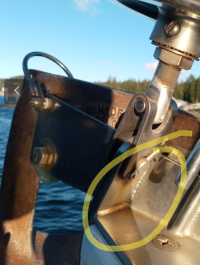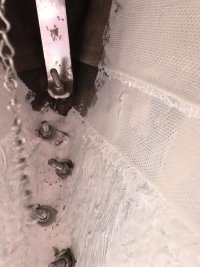tenders
Innocent Bystander
Looks like that raised area is designed to give more stiffness and support to the anchor roller, and maybe create a nice visual line with the toe rail along the sheer. It's probably a slab of wood that's waterlogged and expanding when freezing.
What work exactly won't the marina let you do on site? Probably cutting and grinding - so get yourself an inverter and do what you need to do at anchor.
I'm not sure you yet need to remove the bow pulpit - only the anchor roller, and the horizontal screw going into the forecastle. With the right oscillating saw setup (you can put the blades on at 90 degrees to the handle!), a pack of extra blades, and an hour at anchor with your inverter and the engine running, you should be able to cut the raised area flush with the deck and see what's going on without removing the forestay or the stemplate. If you get the forecastle off in one piece you can fabricate a replacement out of G10 offsite. Go back to anchor when it's time for messy fairing and, if also verboten at the marina, painting. But I gotta believe that small-batch painting like that has gone on at the marina before.
What work exactly won't the marina let you do on site? Probably cutting and grinding - so get yourself an inverter and do what you need to do at anchor.
I'm not sure you yet need to remove the bow pulpit - only the anchor roller, and the horizontal screw going into the forecastle. With the right oscillating saw setup (you can put the blades on at 90 degrees to the handle!), a pack of extra blades, and an hour at anchor with your inverter and the engine running, you should be able to cut the raised area flush with the deck and see what's going on without removing the forestay or the stemplate. If you get the forecastle off in one piece you can fabricate a replacement out of G10 offsite. Go back to anchor when it's time for messy fairing and, if also verboten at the marina, painting. But I gotta believe that small-batch painting like that has gone on at the marina before.
Last edited:




